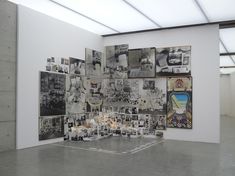Anna Oppermann
Anna Oppermann was born Regina Heine in Eutin, Germany, in 1940. From 1962 to 1968 she studied at the Hamburg University of Fine Arts and philosophy at the University of Hamburg, Germany. In 1967, she married Hamburg artist Wolfgang Oppermann and took his last name and first name Anna as her artist name. In 1968 she became a member of the CO-OP artists cooperative Hamburg. In 1986 she was a co-founder of the artists cooperative "Galerie Vorsetzen", Hamburg (- 1996). After a guest lectureship in Hamburg and a professorship in Wuppertal, she was a professor at the Berlin University of the Arts (today: University of the Arts Berlin) from 1990 to 1993. Oppermann has had numerous solo exhibitions in galleries and museums since the 1970s, including the Hamburg Kunsthalle, participated in documenta 6 in 1977 and documenta 8 in 1987, as well as the 39th Biennale di Venezia, Italy in 1980 and the 5th Biennale of Sidney, Australia in 1984. She has been awarded numerous prizes. She received the Edwin-Scharff-Preis of the Free and Hanseatic City of Hamburg in 1977, the ars-viva-Preis of the Kulturkreis der Deutschen Wirtschaft and the Villa-Romana-Preis Florence in 1977, the Förderpreis Glockengasse in 1980, the scholarship Cité Internationale des Arts Paris in 1981, the Art Prize of the Heitland Foundation, Celle in 1985 and the Barkenhoff-Stipendium with residency in Worpswede. Since 2012, the Berlin University of the Arts has annually awarded the Anna Oppermann Prize for outstanding achievements in artistic practice in the BA program of the Faculty of Fine Arts. Anna Oppermann died in Celle in 1993.
Anna Oppermann developed a characteristic working method in which, over a period of years, she assembled arrangements from a large number of drawings, photographs, picture canvases, and handwritten notes into room-sized installations for which she coined the term "ensembles." According to her own definition, the artist understood these works, which were not subject to any normative system of order, as an offer of interaction. She wanted to be a mediator between the different disciplines, between rationality and sensual perception, between art and science, normal citizens and outsiders. The ensembles revolve around problem areas such as the role of women and artists in the late 1960s, the relationship between normality and outsiderness within the framework of existing social norms, the dynamics of interpersonal relationships, and finally the process of making art itself in relation to the mechanisms of the art market. The individual ensembles did not develop in a linear fashion, but rather in interconnected episodes and had to be rebuilt for each exhibition and, in the process, staged anew, as it were. Since photographs of each new installation are to be integrated into the next set-up, the ensembles continue to grow posthumously. They are designed as open constellations in a state of permanent change. Oppermann is one of those exceptional personalities in the art world who, in the sense of Harald Szeemann's "Individual Mythologies," helped shape a new concept of art in the 1970s, one of processuality and obsessive self-questioning, combined with precise analysis of social and political sensitivities. In 2007, the Generali Foundation in Vienna, together with the Württembergischer Kunstverein in Stuttgart, presented the first comprehensive solo exhibition of Anna Oppermann's work since her death.
read more read less
